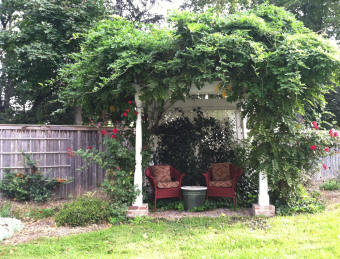|
Go Naturalistic in the Garden
Marann Jones
Adam's County Master Gardener Program
 (11/8) Are you tired of your manicured garden driving you nuts when you see a weed sprouting? Why not break away from the norm and create a naturalistic garden. This garden is not manicured nor is it over run with weeds. Rather it is a garden that speaks to you and your visitors many words
of infinite emotions. It is a garden that provides a sanctuary for wildlife habitats. And, for you the gardener, it never grows old, because there is always life in the garden. Something blooms all year long or has that evergreen appeal from one season to the next. (11/8) Are you tired of your manicured garden driving you nuts when you see a weed sprouting? Why not break away from the norm and create a naturalistic garden. This garden is not manicured nor is it over run with weeds. Rather it is a garden that speaks to you and your visitors many words
of infinite emotions. It is a garden that provides a sanctuary for wildlife habitats. And, for you the gardener, it never grows old, because there is always life in the garden. Something blooms all year long or has that evergreen appeal from one season to the next.
I bet you are saying to yourself aha, that's it! I want that garden but how do I get it?, I shall now put on my master gardener's hat and outline how I went about creating a naturalized garden. The first thing I did was to conduct a thorough site analysis of the space. After I had identified the location, I got my soil tested. This important step
helps you decide what sort of plants to put into your garden and it also tells you how to amend your soil so that you will be able to grow the plants you want. Without testing your soil, you will waste a lot of money and time while wondered why all of your plants are dying. Once these steps were complete, I focused on creating a planting design for the space.
For my designated space, I looked at a wide selection of native plants in order to make the planting landscape attractive. Planting a variety of native plants will also provide food supplies and protective shelter for animals and pollinators, such as seeds, nuts and fruits for squirrels, insects for birds, nectar for hummingbirds and butterflies,
and larval host plants for butterfly caterpillars.
When using these indigenous or naturalized plants, I arranged them in groups to give an effective landscape covering. Many folks aren't aware that some native plants have gorgeous fall foliage and stunning showy flowers, as well as fruits and seeds in abundance that are environmentally safe for wildlife. I used the triangle concept as my guide for
placing these plants - arranging the taller plants at the back and medium size plants in the middle. Ground cover can be added at the edge and at the base of the taller plants once you are sure they have taken root. In this way, the ground cover will grow around the taller plants and choke out the weeds. I also opted to plant bulbs throughout the garden to ensure color in
early spring till early blooming natives are up.
To achieve this naturalistic look, don't just rush out and buy all your flowering plants in the spring. This will only give you a one season garden. As you design your space, choose plants that will allow for four season color and texture displays. Buy throughout the landscape season from April to November. Keep an eye on what is flowering every
month and for how long it is lasting. Make a list of these plants. You can buy and plant right away or you can buy and hold until the fall and plant them all at once.
Let me share a few more tips. I recently have been using what is known as "work horse plants", perennial or herbaceous plants, because they do not let you down. They come back year after year. I also plant some colorful annuals, such as salvias and cleome, to fill in the gaps for quick showy attraction. Often, I use seed packets to plant annual and
perennials in the garden. Remember to mark the areas you have planted with seeds so you won't dig them up accidentally. For boldness, I planted some edible herbs in between. Because I love to add mint to my summer drinks, I made sure that I controlled its spread by cutting off the base of the pot it came in and setting the pot down into the soil so that only the lip of
the pot showed above ground. Be even more bold and daring by weaving some veggies in between your perennials, like collard greens and cabbage. They have wide leaves which will cover the ground and stave off weeds all season long.
Do weed your garden while your plants are getting established. Once these plants take root and are established after about 3 seasons, you will be able to sit back and enjoy the garden. Remember - before you plant, make sure you are aware of the environment of your chosen spot by studying drainage and exposure to sun along with testing your soil.
Have fun as you choose native plants that will add variety and longevity to your annual blooming cycle. Using these tips, you will be well on your way to creating a garden that is pleasing to you and your neighbors. Birds, insects and pollinators will be happy, too!
Read other articles on garden and landscape design
Read other articles by Marann Jones
|